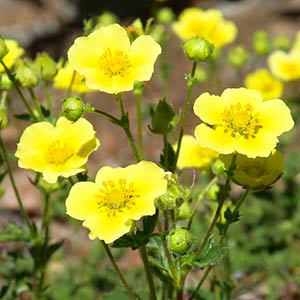Drymocallis pseudorupestris
Drymocallis cuneifolia
cliff drymocallis, cliff woodbeauty, false rock loving cinquefoil, Rocky Mountain sticky cinquefoil
elongate.
elongate.
openly tufted to loosely spaced, (0.3–)0.6–4 dm;
base 1–3 mm diam., ± densely septate-glandular.
openly tufted to loosely spaced, 0.5–4.5 dm;
base 1–2 mm diam., sparsely septate-glandular.
glabrate or sparsely to ± densely hairy;
basal (2–)3–16 cm, leaflet pairs (2–)3–4(–5);
terminal leaflet broadly obovate-cuneate to flabellate, 0.2–3(–4) × 0.5–3 cm, teeth single or double, 2–15 per side, apex usually rounded to truncate, sometimes obtuse;
cauline 0–2, reduced, leaflet pairs 2–3.
sparsely to moderately hairy;
basal 2–15 cm, leaflet pairs (2–)3–5;
terminal leaflet broadly cuneate to nearly round, 0.6–2(–3.5) × 0.5–2 cm, teeth irregularly single, 2–4 per side, apex rounded to truncate;
cauline 0–1(–2), reduced, leaflet pairs 1–2.
2–40-flowered, not or ± leafy, open, 1/6–3/4(–4/5) of stem, ± wide, branch angles (10–)20–40(–50)°.
3–10(–15)-flowered, not leafy, open, 1/4–3/4 of stem, wide, branch angles 20–75°.
3–20 (proximal to 40) mm, not or sparsely to moderately short-hairy, predominantly septate-glandular.
2–15 (proximal to 30) mm, sparsely to moderately short-hairy, septate-glandular.
opening widely;
epicalyx bractlets linear to elliptic, 2–6 × 1–2 mm;
sepals spreading, 4–7(–9) mm, apex acute to obtuse, apiculate;
petals overlapping or not, spreading, cream-white to pale yellow (red-tinged in var. crumiana), narrowly to broadly obovate, 4–12 × 3–11 mm, longer than sepals;
filaments 1–4 mm, anthers 0.7–1.2 mm;
styles thickened, 1–1.5 mm.
opening narrowly;
epicalyx bractlets linear to narrowly elliptic or lanceolate, 1–2 × 0.5 mm;
sepals erect, 2–5 mm, apex broadly obtuse;
petals scarcely overlapping, erect, yellow, narrowly obovate, 2–4 × 1.5–2.5 mm, ± equal to or slightly longer than sepals;
filaments 1.5–2.5 mm, anthers 0.5–0.8 mm;
styles slender, 1.5–2.5 mm.
light brown, 1 mm.
brown, 0.8–1.2 mm.
Drymocallis pseudorupestris
Drymocallis cuneifolia
Varieties 3 (3 in the flora).
Drymocallis pseudorupestris occurs from Alberta and Washington to California and Utah, mostly in montane habitats; it is the species most often associated with rocky habitats, including talus slopes, for which its relatively elongate caudex branches are an obvious adaptation. Vestiture is dominated by abundant septate glands on stems and in the inflorescences. Except for var. pseudorupestris, which occurs only in the northeastern part of the species range, plants are relatively short, usually less than 2.5 dm. Three intergrading varieties accommodate the extremes at the northeastern and southern ends of the range.
(Discussion copyrighted by Flora of North America; reprinted with permission.)
Varieties 2 (2 in the flora).
Drymocallis cuneifolia has a complex nomenclatural history, complicated by the extreme rarity of the typical variety. Rydberg described the species on the basis of a single collection from the San Bernardino Mountains of San Bernardino County, probably near Green Lead Mines. When comparable (though significantly smaller) plants were found in the San Gabriel Mountains of Los Angeles County, P. A. Munz and I. M. Johnston (1925) adopted Potentilla cuneifolia (Rydberg) Th. Wolf for both extremes; this name was later replaced with P. peirsonii because of the earlier P. cuneifolia Bertoloni. In the absence of comparable new collections from the San Bernardino Mountains, D. D. Keck (in J. Clausen et al. 1940) concluded that the type of D. cuneifolia was merely an immature specimen of D. lactea var. lactea and accordingly described P. glandulosa subsp. ewanii to accommodate populations in the San Gabriel Mountains.
The 2004 discovery of a small population of plants comparable to the type of Drymocallis cuneifolia from near the type locality (Elvin 3555, IRVC, UCR) confirms that D. cuneifolia is a valid taxon that shares most of the diagnostic features of populations in the San Gabriel Mountains. Plants in the San Bernardino Mountains tend to be larger than those in the San Gabriel Mountains, with fewer and somewhat differently shaped leaflets; they are accordingly treated here as varieties.
(Discussion copyrighted by Flora of North America; reprinted with permission.)
1. Stems (1–)2–4 dm, bases (1.5–)2–3 mm diam.; basal leaves (4–)7–16 cm; terminal leaflets (1–)2–3(–4) cm, teeth usually double, (5–)8–15 per side; flowers (5–)10–40; petals 6–12 × 5–11 mm, widely overlapping; filaments 2–4 mm. | var. pseudorupestris |
1. Stems (0.3–)0.6–2.5 dm, bases 1–2(–3) mm diam.; basal leaves (2–)3–9(–15) cm; terminal leaflets 0.2–2(–4) cm, teeth single or ± double, 2–8(–12) per side; flowers 2–12(–20); petals 4–8(–9) × 3–6(–8) mm, not or ± overlapping; filaments 1–2.5(–3) mm | → 2 |
2. Basal leaves: leaflet pairs (2–)3(–4); hypanthia and sepals not bristly or bristles less than 1 mm; short hairs sparse to moderately abundant on stems and pedicels (sometimes absent); styles usually golden brown, rarely reddish. | var. saxicola |
2. Basal leaves: leaflet pairs 3–4(–5); hypanthia and sepals prominently bristly, bristles 1–1.5 mm; short hairs absent or sparse on stems and pedicels; styles usually dark red, rarely golden brown. | var. crumiana |
1. Stems 2–4.5 dm; basal leaves 5–15 cm; San Bernardino Mountains. | var. cuneifolia |
1. Stems 0.5–2(–2.5) dm; basal leaves 2–10 cm; San Gabriel Mountains. | var. ewanii |
- Local floras:
BC,
CA,
OR
- Local Web sites:
CalFlora,
CalPhotos,
Flora NW,
PNW Herbaria
WildflowerSearch
iNaturalist (observations)
USDA Plants Database
- LBJ Wildflower Center
- SEINet
- Plants of the World Online
- Encyclopedia of Life
- Wikipedia
- Google Image Search


